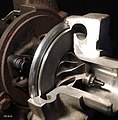Variable turbine geometry loader

A variable turbine geometry charger (VTG charger) or Variable Nozzle Turbocharger (VNT) is an exhaust gas turbocharger that differs from conventional turbochargers in that it has adjustable guide vanes at the turbine inlet. Like a conventional supercharger, it has a turbine wheel and a compressor wheel , which are connected to one another on a shaft.
The swiveling guide vanes are fastened with their shafts on a carrier ring. On the back of the carrier ring, the shafts of the guide vanes have a guide pin that engages in an adjusting ring. All guide vanes are turned simultaneously using the adjusting ring. The adjusting ring is moved either by a servomotor or by a vacuum unit .
The guide vanes reach their flattest position at the greatest negative pressure on the pressure cell attached to the outside of the turbocharger. If the vacuum at the pressure cell is low, the guide vanes are made steeper by a spring in the pressure cell. The adjustment causes the turbine wheel to flow against the turbine wheel at high circumferential speed even with small amounts of exhaust gas, i.e. at low load and low engine speed, and the losses on the blades due to the inlet impact remain small. If the amount of exhaust gas is small, the guide vanes are flattened; the result is a smaller cross-section in the vanes for the exhaust gases. The few exhaust gases have to flow faster so that the same amount of exhaust gas can flow through the guide vanes at the same time. As a result, the speed of the charger is higher in this operating state and in the event of a load change (sudden acceleration) the charger builds up pressure more quickly because it does not have to rev up first (the " turbo lag " is reduced).
As the amount of exhaust gas increases, the radial velocity of the exhaust gas increases, the guide vanes are set steeper, the cross-section increases, the circumferential speed of the gas changes less and the boost pressure and the turbine power remain more or less constant.
Since a VTG charger is usually controlled with negative pressure or electrically, it has to be constantly regulated - in contrast to wastegate chargers, which control themselves with their own excess pressure. The steepest position of the guide vanes and thus the largest possible inlet cross-section is also the emergency running position of the VTG charger if the control fails. This position usually enables a negligible boost pressure and thus prevents uncontrolled overcharging of the engine.
Advantages of the VTG charger:
- Reduction or even avoidance of the turbo lag
- adjustable over the entire speed range (e.g. engine brake in overrun mode)
- high engine torque in the lower and upper speed range
- Reduction of the pollutants in the exhaust gas over the entire speed range
Disadvantages of the VTG charger:
- If the engine setting is incorrect, the VTG adjustment can be contaminated by exhaust gas residues, often when driving short distances or driving too “leisurely”.
- The moving parts in the hot exhaust gas flow can be prone to failure
literature
- John D. Humphries: Automotive Technical Manual for Turbochargers and Supercharged Engines. 1st edition, Schrader Verlag GmbH, Suderburg-Hösseringen 1993, ISBN 3-921796-05-9 .
- Gert Hack, Iris Langkabel: Turbo and compressor motors . 1st edition, Motorbuch Verlag, Stuttgart 1999, ISBN 3-613-01950-7 .
- Richard van Basshuysen and Fred Schäfer: Handbook Internal Combustion Engine: Fundamentals, Components, Systems, Perspectives. Vieweg + Teubner Verlag, 2009.




